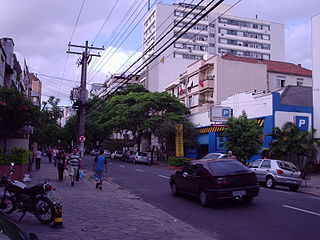
The Azenha Bridge (Portuguese: Ponte da Azenha) is located in the Azenha neighborhood, in the Brazilian city of Porto Alegre, in the state of Rio Grande do Sul. It is situated on the corner of Azenha and Ipiranga avenues. [1]

The Azenha Bridge (Portuguese: Ponte da Azenha) is located in the Azenha neighborhood, in the Brazilian city of Porto Alegre, in the state of Rio Grande do Sul. It is situated on the corner of Azenha and Ipiranga avenues. [1]
The original Azenha Bridge was built in 1777 by Francisco Antonio da Silveira, known as Chico da Azenha, an Azorean who arrived in Porto Alegre in the middle of the 18th century. The site, built above the Dilúvio Stream, connected the south to the center of Porto Alegre. The road from the bridge to the historic center became known as the Azenha Way, which today corresponds to João Pessoa and Azenha avenues. [2]
On the night of September 19, 1835, around two hundred rebels camped in the Azenha neighborhood from Guaíba. Led by Gomes Jardim and Onofre Pires, their aim was to invade Porto Alegre. On the 20th, the revolutionaries entered the city without encountering any opposition. Antônio Rodrigues Fernandes Braga, president of the Province of São Pedro do Rio Grande do Sul, escaped and traveled to Rio Grande. Without a fight, the revolutionaries asserted their absolute control over the city and gained a lot of support in the interior of the province. The City Council, convened extraordinarily by Bento Gonçalves on September 21, swore in Marciano Pereira Ribeiro, who was fourth in the general order of precedence of the vice-presidents of the province. [2] [3]
On June 29, 2008, the Azenha Bridge reopened after renovation featuring a theatrical presentation of the historic battle between the revolutionaries and the imperials. The show was performed by actors and riders from the Movimento Tradicionalista Gaúcho (MTG) and included a performance by musician Renato Borghetti. The restoration cost R$531,000 and preserved the original features of the bridge, which was painted to prevent graffiti and given a new lighting system. However, the steps leading down to the Dilúvio Stream have been modified to prevent people from occupying the lower part of the bridge. [4] [5]

Porto Alegre is the capital and largest city of the Brazilian state of Rio Grande do Sul. Its population of 1,488,252 inhabitants (2020) makes it the 12th-most populous city in the country and the center of Brazil's fifth-largest metropolitan area, with 4,405,760 inhabitants (2010). The city is the southernmost capital city of a Brazilian state.

Rio Grande do Sul is a state in the southern region of Brazil. It is the fifth-most populous state and the ninth-largest by area. Located in the southernmost part of the country, Rio Grande do Sul is bordered clockwise by Santa Catarina to the north and northeast, the Atlantic Ocean to the east, the Uruguayan departments of Rocha, Treinta y Tres, Cerro Largo, Rivera, and Artigas to the south and southwest, and the Argentine provinces of Corrientes and Misiones to the west and northwest. The capital and largest city is Porto Alegre. The state has the highest life expectancy in Brazil, and the crime rate is relatively low compared to the Brazilian national average. Despite the high standard of living, unemployment is still high in the state, as of 2017. The state has 5.4% of the Brazilian population and it is responsible for 6.6% of the Brazilian GDP.

The Ragamuffin War or Ragamuffin Revolution was a Republican uprising that began in southern Brazil, in the province of Rio Grande do Sul in 1835. The rebels were led by generals Bento Gonçalves da Silva and Antônio de Sousa Neto with the support of the Italian fighter Giuseppe Garibaldi. The war ended with an agreement between the two sides known as Green Poncho Treaty in 1845.

Sport Club Rio Grande is a professional association football club based in Rio Grande, Rio Grande do Sul, Brazil. Founded in July 1900, they are Brazil's oldest active football club.

Rio Grande is a municipality (município) and one of the oldest cities in the Brazilian state of Rio Grande do Sul. It was the state capital from 1835 to 1845. It is the most important port city in the state and has one of the most important maritime ports in Brazil.

The Economy of Porto Alegre is the fastest growing economy in Brazil and is currently the country's 7th largest regional economy. The city of Porto Alegre has a population of approximately 1.4 million people. The history of Porto Alegre, particularly during the industrial revolution established its economy and the basis of the current industrial sector in the city.

Cidade Baixa is a neighborhood of the city of Porto Alegre, the state capital of Rio Grande do Sul in Brazil. The neighborhood was created by the law number 2022 of December 7, 1959.

Centro Histórico is a neighborhood of the city of Porto Alegre, the state capital of Rio Grande do Sul in Brazil.

Praia de Belas is a neighborhood of the city of Porto Alegre, the state capital of Rio Grande do Sul, Brazil. It was created by Law 2022 from December 7, 1959.

Bom Fim is a neighborhood in the city of Porto Alegre, the state capital of Rio Grande do Sul in Brazil. It was created by the law number 2022 from December 7, 1959.
Vila Ipiranga is a neighbourhood (bairro) in the city of Porto Alegre, the state capital of Rio Grande do Sul, in Brazil. It was created by Law 2022 from December 7, 1959.

The Legislative Assembly of Rio Grande do Sul is the regional parliament of Rio Grande do Sul, a federative unit in Brazil. It has 55 state deputies elected every 4 years.

The history of Porto Alegre, capital of Rio Grande do Sul, Brazil, officially begins on March 26, 1772, when the primitive village was elevated to the condition of a parish. However, its origins are older, since the settlement was created as a result of the colonization of the area by Portuguese ranchers in the 17th century. The region, in fact, has been inhabited by man since 11,000 years ago. Throughout the 19th century, the settlement began to grow with the help of many European immigrants of various origins, African slaves, and portions of Hispanics from the River Plate region. At the beginning of the 20th century, Porto Alegre's expansion acquired a very accelerated rhythm, consolidating its supremacy among all the cities in Rio Grande do Sul and projecting it on the national scene. From then on, its most characteristic traits, only sketched out in the previous century, were defined; many still remain visible today, especially in its historic center. Throughout the entire 20th century, the city strove to expand its urban network in an organized way and provide it with the necessary services, achieving significant success, but also facing various difficulties, at the same time as it developed its own expressive culture, which, at some moments, influenced other regions of Brazil in many fields, from politics to the plastic arts. Today, Porto Alegre is one of Brazil's largest capitals and one of the richest and one with the best quality of life, having received several international distinctions. It hosts many important events and has been pointed out several times as a model of administration for other large cities.
The following is a timeline of the history of the city of Porto Alegre, in the state of Rio Grande do Sul, Brazil.
The 2022 Campeonato da Primeira Divisão de Futebol Profissional da FGF - Divisão Especial - Série A1, better known as the 2022 Campeonato Gaúcho, was the 102nd season of Rio Grande do Sul's top flight football league. The competition was played from 26 January to 2 April 2022. 12 clubs contested in the Campeonato Gaúcho. Grêmio were the four-time defending champion.

The Battle of Azenha Bridge was the first battle of the Ragamuffin War, which took place on the night of the 19th to the 20th of September 1835. It gave way to the capture of Porto Alegre by the rebels on the following day.

The capture of Porto Alegre was one of the starting points of the Ragamuffin War. It took place on 20 September 1835, the day after the Battle of Azenha Bridge. Its date has been celebrated as a state holiday in Rio Grande do Sul since 1995 and also marks the end of Farroupilha Week, between the 14th and 20th of September.
The 2023 Campeonato da Primeira Divisão de Futebol Profissional da FGF - Divisão Especial - Série A1, better known as the 2023 Campeonato Gaúcho, was the 103rd season of Rio Grande do Sul's top flight football league. The competition was played from 21 January to 8 April 2023. 12 clubs contested in the Campeonato Gaúcho. Grêmio were the fifth-time defending champion.

Arroio Dilúvio is a brook (arroio) in Porto Alegre, Rio Grande do Sul, Brazil, that flows in areas with high population density. It was or still is known by other names: Riacho Ipiranga, Arroio da Azenha, Riacho or Riachinho and even Arroio do Sabão, this being the current name of the stream that gives it its most distant source.

Antônio Rodrigues Fernandes Braga was a Brazilian judge, county ombudsman, and politician. He was a general deputy to the General Assembly and the provincial governor of the province of Rio Grande do Sul from 2 May 1834 to 21 September 1835. He was the provincial governor at the outbreak of the Ragamuffin War in Rio Grande do Sul. He also served as a senator from Rio Grande do Sul and as a justice to the Supreme Court of Justice, nominated to the latter by imperial letter on 27 April 1870 and serving from 1870 to his death in 1875.
![]() Media related to Ponte da Azenha at Wikimedia Commons
Media related to Ponte da Azenha at Wikimedia Commons